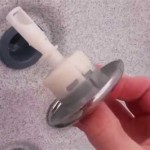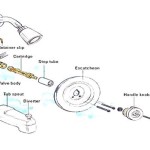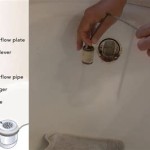How to Unclog a Bathtub Drain Without Vinegar
A clogged bathtub drain is a common household problem that can disrupt daily routines and lead to frustration. Hair, soap scum, and mineral buildup are frequent culprits behind these blockages. While many homeowners immediately reach for chemical drain cleaners or vinegar-based solutions, alternative methods exist that are equally effective, often safer for pipes, and may be readily available in the home. This article will provide detailed instructions on how to unclog a bathtub drain without relying on vinegar.
Plunger Power: A Manual Approach
The first line of defense against a clogged bathtub drain should be a plunger. This simple tool utilizes suction and pressure to dislodge obstructions. The effectiveness of a plunger depends on the proper technique and creating a tight seal around the drain opening.
Begin by ensuring the bathtub contains enough water to cover the rubber cup of the plunger. If the water level is too low, add more until the plunger is submerged. An insufficient amount of water will reduce the plunger's ability to create suction and effectively dislodge the clog.
Next, position the plunger directly over the drain opening, ensuring the entire rubber cup is submerged. Create a tight seal by pressing down firmly on the edges of the cup. This seal is crucial for generating the necessary pressure to move the clog.
Once the seal is established, begin plunging vigorously, using an up-and-down motion without breaking the seal. Avoid lifting the plunger completely off the drain with each stroke. Instead, maintain constant pressure and focus on pushing and pulling the water through the drain. Continue plunging for several minutes, monitoring for any changes in the drain’s ability to flow.
After several minutes of plunging, remove the plunger and observe if the water drains more freely. If the clog persists, repeat the plunging process several times. Persistent clogs may require multiple attempts before the obstruction is dislodged. If the water begins to drain slowly, continue plunging until the drain is completely clear.
If the bathtub has an overflow drain, sealing it off during the plunging process is essential. This prevents air from escaping and maximizes the pressure directed towards the clog. A wet cloth or duct tape can effectively seal the overflow drain. Ensure the seal is airtight to optimize the plunger's effectiveness.
For stubborn clogs that do not respond to simple plunging, consider using a flange plunger, also known as a toilet plunger. These plungers have a soft rubber flap that folds out from the cup, creating a tighter seal around the drain opening. The flange can be folded inward for use on flat surfaces like bathtub drains. The enhanced seal provides greater suction and pressure, potentially dislodging more resistant blockages.
The Hair Removal Tool: A Direct Approach
The most common culprit behind bathtub clogs is hair. A hair removal tool, often a flexible plastic stick with barbs or bristles, is designed to reach into the drain and physically remove accumulated hair and debris. These tools are inexpensive and readily available at most hardware stores.
Before using the hair removal tool, remove the drain stopper or strainer. Many bathtub drains have stoppers that can be easily lifted out or removed with a screwdriver. Removing the stopper provides unimpeded access to the drainpipe.
Carefully insert the hair removal tool into the drain opening, gently pushing it down as far as it will go. Rotate the tool as it is inserted to catch more hair and debris. Avoid forcing the tool if it encounters resistance, as this could damage the tool or the drainpipe.
Once the tool is fully inserted, slowly pull it back out, rotating it as you go. Examine the tool for any hair, soap scum, or other debris that has been retrieved. Dispose of the debris properly and repeat the process until the tool comes out clean.
If the drain is particularly clogged, multiple insertions and removals may be necessary to clear the obstruction completely. Be patient and persistent, ensuring that all visible debris is removed from the drain.
After removing the visible debris, flush the drain with hot water to dislodge any remaining loose particles. Run the hot water for several minutes to ensure the drain is flowing freely. If the drain still appears to be clogged, consider using another method, such as baking soda combined with hot water.
Some bathtub drains have a more complex stopper mechanism that requires disassembly to access the drainpipe. Refer to the bathtub's manufacturer's instructions or online resources for guidance on safely removing the stopper without causing damage to the drain assembly.
Baking Soda and Hot Water: A Gentle Chemical Reaction
Baking soda, also known as sodium bicarbonate, is a natural cleaning agent that can be used to unclog bathtub drains. When combined with hot water, it creates a mild chemical reaction that can help to break down grease, soap scum, and other organic matter that contribute to clogs.
Begin by pouring approximately one cup of baking soda down the drain. Ensure the baking soda is poured directly into the drain opening and not scattered around the tub. This concentrates the cleaning power where it is needed most.
After pouring the baking soda, slowly pour about three cups of hot (but not boiling) water down the drain. Boiling water can potentially damage PVC pipes, so it is best to use hot water from the tap. The hot water activates the baking soda, creating a fizzing reaction.
Allow the baking soda and hot water mixture to sit in the drain for at least 30 minutes, or preferably overnight for more stubborn clogs. This allows the baking soda to break down the clog and loosen the debris.
After the soaking period, flush the drain with hot water to remove any remaining debris. Run the hot water for several minutes to ensure the drain is flowing freely. Monitor the drain for any signs of improvement.
If the clog persists after the initial treatment, repeat the baking soda and hot water process. Multiple applications may be necessary to fully clear the obstruction. Patience is key when using this method.
For particularly stubborn clogs, consider using a combination of baking soda and salt. Add about half a cup of salt to the baking soda before pouring it down the drain. The salt acts as an abrasive, helping to scrub the inside of the drainpipe and dislodge stubborn debris. Follow the same procedure as with baking soda and hot water alone, allowing the mixture to sit for at least 30 minutes before flushing with hot water.
Preventative measures are essential to avoid future clogs. Regularly flush the bathtub drain with hot water after each use to remove any loose hair or soap scum. Consider installing a drain strainer to catch hair and debris before it enters the drainpipe. Clean the strainer regularly to prevent it from becoming clogged. Avoid pouring grease or other oily substances down the drain, as these can solidify and contribute to clogs. By following these simple steps, homeowners can significantly reduce the likelihood of future bathtub drain problems.

Quick Tips To Unclog A Bathtub Drain Without Chemicals Plumbing Authority Inc

How To Unclog A Bathtub Drain In 5 Minutes Or Less

How To Easily Unclog A Drain Without Harsh Chemicals Baking Soda Vinegar

How To Unclog A Bathtub Drain Without Chemicals

How To Unclog A Bathtub Drain Without Chemicals Family Handyman

How To Unclog A Bathtub Drain 11 Diy Clog Busters

3 Simple Ways To Unclog A Bathtub Drain Naturally Wikihow

How To Unclog A Bathtub Drain Without Chemicals Family Handyman

3 Simple Ways To Unclog A Bathtub Drain Naturally Wikihow

How To Unclog A Bathtub Drain Without Chemicals
Related Posts








